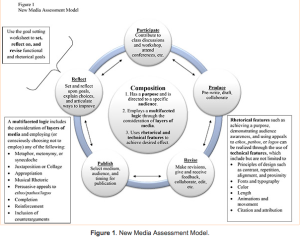VanKooten, Crystal. “Toward a Rhetorically Sensitive Assessment Model for New Media Composition.” Digital Writing Assessment and Evaluation. Eds. Heidi A McKee and Dànielle Nicole DeVoss. Computers and Composition Digital Press, 2013. Web. 3 Feb. 2014.
Situating herself inside three established assessment models — Paul Allison (2009), Eve Bearne (2009), and Michael Neal (2011)– Van Kooten creates a new model meant to assess new media composition. This adaptable model takes into account both process and product, functional and rhetorical literacies, and requires student self-assessment and reflection . Van Kooten details the theory and framework for the model, then demonstrates — using student voices — the implementation and assessment of it. The chapter functions as a true multi-modal text, replete with 7 short videos (with accompanying transcripts) to demonstrate the kinds of “multifaceted logic” and “layers of media” that are employed using a variety of rhetorical and technical features to accomplish a specific purpose for a particular audience.
Van Kooten narrates the difficulty in creating a new media assessment model and her journey toward the model she unveils here. She notes that the first attempts she made, along with her students who collaboratively created the rubric for their own work, were outgrowths of the print media rubrics, and that they quickly revealed their shortcomings, due to the affordances of various media that could be incorporated. For example, arguments are presented differently using sound and visuals, and what constitutes evidence and organization varies by media. Michael Neal (2011) proposed that the proliferation of multi-modal texts has created what he calls a “kairotic juncture” — an opportunity for a new model, which Van Kooten responds to, however cautiously, noting that “there is currently no agreed-upon language or vocabulary for discussing new media texts” nor any stability in new media genres. She hopes the model she proposes opens the conversation about new media assessment and the opportunity for further evolutions that remain grounded in “a solid theory of writing assessment itself.”
Van Kooten offers three criteria for assessment:
- fulfillment of purpose and direction to audience;
- the use of a multifaceted logic through consideration of layers of media; and
- the use of rhetorical and technical features for effect.

Van Kooten’s model for assessment of New Media Composition includes both functional and rhetorical literacies.
She also offers two worksheets to help students set both functional and rhetorical goals for their work, involving them in the assessment process and requiring metacognition and reflection — ways of assessing both process and product.
It is my opinion that Van Kooten has created a plausible model, grounded in both (print) writing assessment theory and multi-modal composition theory, that will become an oft-cited text as this conversation continues. This article is a useful source for a go-to model that can be adapted for classroom use.
As mentioned, there are seven accompanying videos that demonstrate new media compositions and turn the chapter itself into a multi-modal piece. Here is a metacognitive piece where one of Van Kooten’s students overdubs his piece with his own narration of the process. This itself is a viable product, as we have director’s cuts with commentary on the special editions of movies and TV episodes, where the audience is privileged to have a window into the mind of the director or actor.
http://ccdigitalpress.org/dwae/files/0901.webm
(I am unable to upload and embed the video as it exceeds the maximum allowable file size for WordPress).

3 Responses to ” Toward a Rhetorically Sensitive Assessment Model for New Media Composition” – Crystal Van Kooten Annotated Bibliography Entry